Sailing ships were formerly classified by their size or employment, but it is now the custom to distinguish different types of vessels by defining their characteristic rigs
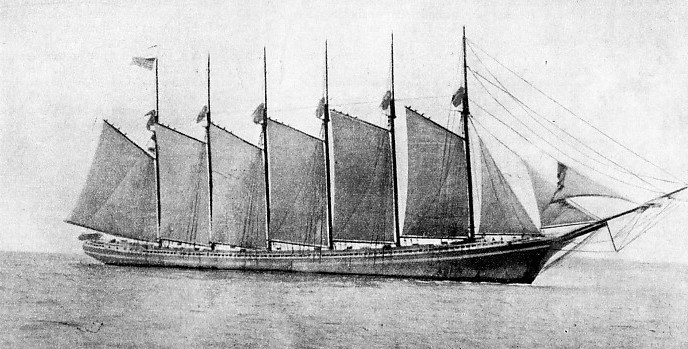
A SIX-MASTED FORE-AND-AFT SCHOONER of 3,730 tons gross. Any vessel with two or more masts of approximately equal size fore-and-aft rigged is defined as a schooner. The Americans built a number of multi-masted schooners. The Wyoming was built in 1909 at Bath, Maine, and is shown above shortening sail. She was 329 ft. 6 in. long, with a beam of 50 ft. 1 in. In March 1924 she went ashore on the American coast during a voyage from Chesapeake Bay with a cargo of coal.
THE subject of a sailing ship’s rig is the basis of all study of sail. In its principles, rig is simple enough, but the student will find an extraordinary number of ramifications. The whole system is comparatively modern, for in the old days different types of vessels were named from their size and duty only, without reference to the details of their rig. It was only later that vessels were classified according to their characteristics, a change that was partly due to the general tendency to classify everything, partly to the greater interchange of ideas, and partly to the growing commercialism. Since many of the old names were adopted to define the new types, confusion resulted.
The general principles of the rig of sailing ships are simple. The most important factor in determining the rig of a sailing vessel is the arrangement of sails on the various masts, some squaresails, some fore-and-aft. Strictly speaking, the matter is decided not by the sails, but by the masts themselves. If the masts have tops, they are square rigged. If the masts have cross-trees,
the sails are known as fore-and-aft sails. Most people, however, are content to judge a vessel’s rig by her sails, which go with the mast in almost every instance; but occasionally an owner would change the canvas on a mast from square to fore-and-aft to economize in men without changing the mast itself. Thus confusion might arise. Anybody seeing the vessel at sea would immediately call her a barque, but the classification societies, which are painstakingly accurate, would still describe her as a ship in their register books. Many a student has found this fact confusing and has unjustly condemned the registers.
The name “ship” formerly signified only the biggest class of vessel without reference to the arrangement of her sails. The modern definition of a “ship” is a vessel with three or more masts, all of them square-rigged. The rig originated in Tudor days when ships were attempting to keep station when sailing in convoy or squadron. A mizen topsail which could be backed against the other sails permitted the speed of the vessel to be regulated much better than had been possible before. It is doubtful whether its inventors had any intention of increasing the speed of the ship by rigging the mizen in that way. The topsail soon had sails put over it, the topgallants and royals, and finally a sail was put under it, the mizen course or crossjack - “cro’jack” as it was always called. Once the full “ship” rig was established in that way it was in general use for many years.
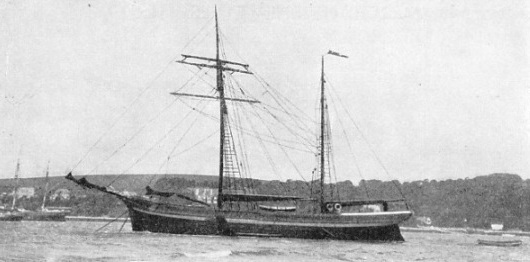
THE KETCH BARGE was formerly an exceedingly popular rig on the coast, with or without square topsails on the foremast. The Goldfinch was built in 1894 of wood, and her rig is of a type now disappearing. She has a gross tonnage of 144, a length of 98 ft 6 in and a beam of 22 ft 7 in. In 1930 she sailed from Plymouth to the West Indies in forty-five days.
A squaresail always demands more men to handle it than a fore-and-aft sail. The full-rigged ships were therefore extravagant in men, but this consideration had little influence, as most vessels needed a big crew to man their armament and most owners spent as little on the men as possible. Warships, Indiamen, Blackwall frigates and clippers were all ship-rigged as a matter of course.
Even the sailing counterpart of the modern tramp, although she had to cut down her expenses wherever possible, spared the men needed for handling “ship” rig. The majority of ships had three masts, but a few had four. One ship only, the famous German Preussen, whose wreck was to be seen near the South Foreland for many years, had five masts.
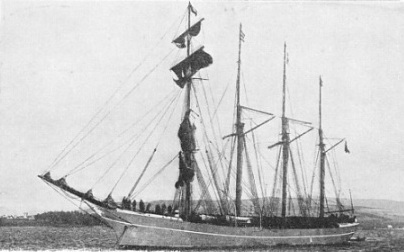
INNOVATIONS IN THE RIG of the four-masted barquentine Westfield, 1,108 tons gross, include booms at the top of the main and mizen lower masts to save work in dipping over the gaff topsail tacks and sheets when tacking. Built in 1896, the Westfield was 210 ft 6 in long, with a beam of 35 ft 7 in. The photograph shows her waiting off Greenock (Renfrewshire) for a tug to tow her to sea. She was wrecked in 1923 after she had been sold to Italy and renamed Felicina.
Although the full ship rig permitted the greatest possible spread of canvas, it was not ideally efficient, for in most directions of the wind there was certain to be some blanketing. It was only in an exceptionally favourable wind that a ship set all her canvas and got the full benefit of the spread. So, in the nineteenth century, when sailing ships were having to fight the steamers hard for every bit of their business and economy was all-important, the fashion started of cutting down ship rig to barque rig by removing the yards from the mizen and increasing the fore-and-aft canvas.
This change meant an appreciable saving in the cost of the crews and it was soon found that it made little, if any, difference to the speed. As soon as this was realized hundreds of ships were converted into barques and most of the new tonnage built was of barque rig. Now there is not a single ship-rigged vessel engaged on overseas trade. The Grace Harwar, broken up in 1935, was the last. Many survived for some years only because the square rig on the mizen was particularly useful for training apprentices since they could do their work directly under the eye of the officers on the poop. In most of the later ships the mizenmast was the particular care of the apprentices, and even to-day certain sail training ships are ship-rigged. The full-rigged ship carried the fore-and-aft canvas that was considered necessary for her sailing without compromising her right to be called ship. This fore-and-aft canvas consisted of the headsails, the various staysails, whose number varied, and the spanker. It made a big difference to the sailing qualities of the ship.
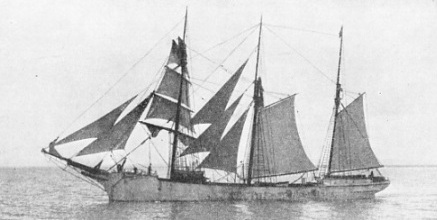
A BARQUENTINE is square-rigged on the foremast and fore-and-aft rigged on the other masts. The Elizabetha has lower, topmast and topgallant staysails set between fore and mainmasts. Except for the Joseph Conrad and the Diego, she was the last British deep-water square-rigger. She was wrecked in March 14, 1934.
The “barque” may be described in general terms as a ship with the after mast fore-and-aft rigged. This definition, however, does not apply to several steamers which, at a time when they all carried canvas, made certain changes in rig on account of the smoke from the funnel and the necessity of avoiding back draught. The sailor himself had his own practical way of dealing with such variations Anything out of the ordinary was labelled “Jackass”.
“Baldheaded” Barques
In the same way as the ships, the majority of barques were given three masts for many years, but later there were a large number of four-masted barques, far more than there were of four-masted ships. The general tendency of sailing vessels was to increase in size, and it was soon found that it was most economical to have the sail plan as square as possible instead of being too lofty. Comparatively few barques used skysails even in the heyday of sail. When the prosperity of sail declined, rigs were cut down more and more until barques became what the sailor called “baldheaded”. In addition to needing less men, the lower sail plan saved money spent on material, for it was not necessary to spend so much on the careful staying of the masts and far less strain was imposed on the gear.
Akin to the barque in the arrangement of the sail is the “polacre”, an essentially Mediterranean type, although during the nineteenth century it was occasionally found in British vessels, particularly in those hailing from the west coast. Its lightness, however, was against its general use round Great Britain.
The principal characteristics of the polacre were the masts, which had no tops or crosstrees and which were as smooth as possible, sometimes being in one piece. The squaresails could thus be lowered right down on to the lower yard, instead of being strictly divided by the tops and stays. Although the sail plan usually approximated to that of a barque, a mizen topsail was often carried.
Ships and barques were generally large. There were some, usually built for a special purpose, which were quite small and regarded as unconventional. One of these is Mr. A. J. Villiers’ little full-rigged ship Joseph Conrad, of only 212 tons gross, but she was built as the training ship Georg Stage. More normally the smaller vessels were two-masted.
Of the two-masted types the most popular for many years was the “brig” and the similar type the “snow”. It is difficult to state when these rigs first came into use and when two-masted ships were given square canvas on the two masts. The term brig is frequently used, but there is nothing to show whether it indicates the rig, whether it refers to other characteristics or employment of the vessel, or whether it is merely a contraction of the word brigantine.
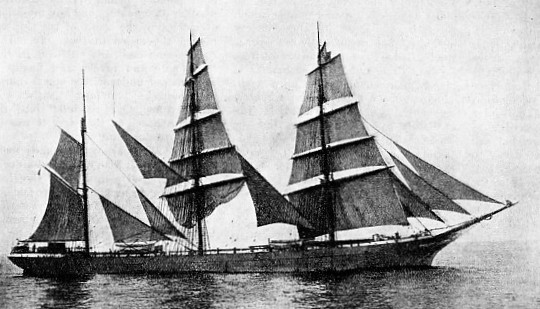
ORIGINALLY A FULL-RIGGED SHIP (square-rigged on ail three masts) the Ventura had her yards removed from her mizenmast. Thus she was generally regarded as having been reduced to barque rig, with fore-and-aft sails on the mizen. The Ventura, however, still retained her ship’s masts, which are in three sections—lowermast, topmast and topgallant mast. The mizenmast of a barque-rigged vessel is in two sections —a lowermast and a long topmast. The Ventura, 1,700 tons gross, was built at Dumbarton in 1886, with a length of 258 ft. 6 in. and a beam of 39 ft. 1 in. She did not survive the war of 1914-18.
Some people think that the brig must have been developed in the sixteenth century. Some believe that it was much later. It is certain that there were large numbers of vessels so rigged in the eighteenth century and that they were put to a variety of uses. This type of rig was beautiful to look at. With a big crew it was a handy rig and, given a good hull, it could produce a fine turn of speed. The Navy found the brig useful for convoying, dispatch-carrying and many other duties. The privateer favoured the brig more than most rigs, and it was often only one step from privateering to piracy. Many of the overseas trade routes were inaugurated by brigs, and for many years brigs formed the backbone of the large coasting fleet that carried coal from the north-east coast of Great Britain to London.
In its later days the brig rig was generally associated with bluff-lined and clumsy vessels, but a hundred years ago there were many brigs with almost clipper hulls and an enormous spread of canvas. They were capable of high speeds, but many were “over hatted” and capsized.
For a long time the brig proper carried no square mainsail, for the lower part of the mainmast was regarded too useful in taking the hoops of the fore-and-aft gaff mainsail. It was realized, however, that both sails were useful and accordingly the “snow” type came into existence, although it disappeared in the present century. So that the hoops of the gaff mainsail might not interfere with the squaresail a trysail mast was fitted. This ran parallel to the mast, secured with a wooden step on the deck and an iron clamp on the after side of the top. It was used only for the gaff mainsail or trysail.
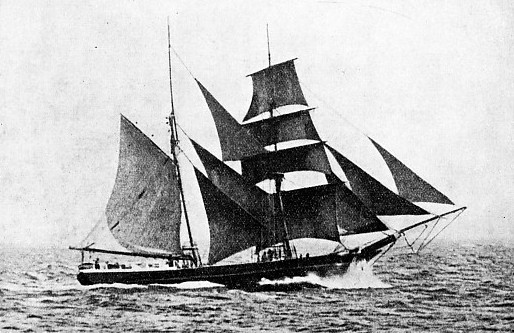
HAVING SQUARESAILS ON THE FOREMAST and fore-and-aft sails on the mainmast, the Elizabeth McLea is classed as a brigantine. The Elizabeth McLea, built in 1860, is pitching into a head sea in the Bristol Channel, virtually under full sail.
The snow rig was at one time frequently to be seen round the coast of Great Britain. The last snow, the Commerce of Newhaven, was built in 1862 and existed until 1909. It is surprising, therefore, how much argument there is about the characteristics of the snow rig.
Squaresails, as already stated, need more men to handle them than fore-and-aft sails. The squaresail has to be gathered up to the yard and made fast in several places by manual labour. The fore-and-aft sail will come down with a run as soon as the halyards are let go. When the ship is put about the squaresails have to be laboriously hauled over by the braces. The fore-and-aft sail goes over by itself and the difficulty is often to check it. Therefore it was only a logical development that the brig and the barque should come to be generally adapted for small crews.
This was done by changing some of the square canvas for fore-and-aft rig, leaving only the foremast in its original state. The vessel thus evolved out of the brig is now known as a “brigantine”. This name appears to have originated in a word signifying brigand, but it is now a particular rig that for many years was known as the hermaphrodite brig. The old “schooner-brig” and “brig-schooner” were variations of this rig. The brigantine rig was exceedingly useful, especially in the coasting trade, where the rapidly growing competition of the steamer had made the brig too expensive to maintain.
Similarly the adaptation of the barque was the “barquentine”, occasionally known as the “three-masted brigantine”, which in the principles oi its sail plan was akin to the caravel of the fifteenth and sixteenth centuries. The barquentine rig too was popular round the coast, and many brigs were converted to it. It reduced the expense of the square rig and brought the individual sails down to a size that could be easily handled.
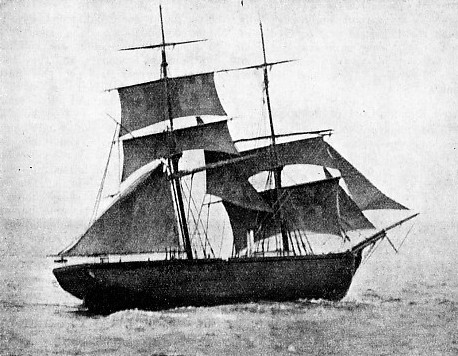
THE SNOW RIG IS DISTINGUISHED FROM THE BRIG by the little mast which is fitted abaft the main lowermast. The fore and mainmasts are square-rigged and a spanker is set on the trysail mast. This photograph shows the Millie. The snow rig fell out of use in the early years of the twentieth century.
In the last days of sail, when sailing ships could retain the vestiges of their prosperity only by the greatest effort, the barquentine rig was adopted by a number of large ocean-going vessels to secure the greatest possible economy. They succeeded fairly well in certain trades, notably the lumber and sugar trades in the Pacific, whose routes took them over seas favoured by almost constant winds. The fore-and-aft sail was then at its best for close-hauled work and the square-rigged foremast for running. When these vessels were put on to such general trades as the South Australian grain run, they were usually much slower than the barques. Some barquentines were given more than four masts, especially those in North American waters.
Schooners are numerous and of many classes. A schooner may be defined as a vessel with more than one full fore-and-aft mast. Schooners have been built with as many as six and, in one instance, with seven masts. This vessel, the Thomas W. Lawson, is illustrated in the chapter “Novelties in Ship Design”. There is a legend to the effect that in 1713 Andrew Robinson, a shipbuilder of Gloucester, Mass., launched a vessel in the presence of a large crowd. She took the water in fine style, and a woman was heard to exclaim, “See how she scoons,” using a phrase for skimming over the water. “Then a schooner she shall be,” said Andrew Robinson, and that is how the word schooner is supposed to have originated. It is a good story but an obvious anachronism, for, taking it that the essentials of a two-masted schooner are two gaff sails and headsails, such vessels existed long before Robinson’s day. There is no evidence at all to say how his vessel was rigged, and the “scooning” concerned the hull only.
Low Running-Cost of Schooners
The French goélette, a variation of the schooner type, takes its name from the Breton word for a seagull. There is something strongly reminiscent of a seabird’s flight in the movements of a pretty schooner.
The great majority of the commercial sailing vessels surviving to-day are schooner rigged, for that has always been the most popular fashion in the minor trades which have to practise the greatest economy.
On the Grand Banks, on the coast of Australia, in Arctic waters, and on the British coast, schooners, a pitiful band of survivors, are still to be found working industriously.
Some of these schooners are pure fore-and-aft vessels. Some have square topsails on their foremast and are technically “topsail schooners”. These squaresails are normally limited to the foremast but by no means necessarily. Formerly a number of them carried square canvas on their mainmast as well; it made no difference to their rig provided the masts were not fitted with tops.
Towards the end of the nineteenth century the Americans, who had made a great reputation with their clipper ships, found them outclassed by the more economical steamer. They tried to keep sail prosperous by building multi-masted schooners, and they succeeded tolerably well in this until after the war of 1914-18, when they were severely handicapped by the craze for immediate delivery of goods. No ship propelled by the wind could regularly keep to the time-table demanded, so that these big schooners, as they were wrecked or broken up, were not replaced.
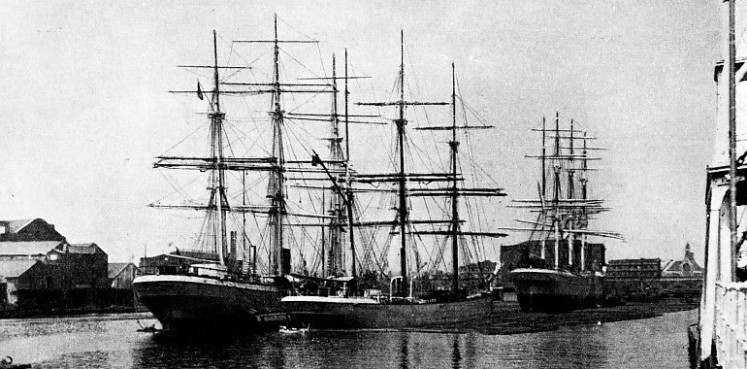
A FULL-RIGGED SHIP, A THREE-MASTED BARQUE AND A FOUR-MASTED BARQUE. On the left is the Marechal de Castries, a full-rigged ship, built at Nantes, France, in 1901. The barque Dee (centre), is fore-and-aft rigged on her mizenmast. She was built at Port Glasgow in 1885. On the right is the four-masted barque Jeannette Francoise, built at Krimpen, Holland, in 1892. Three of her masts are square-rigged and her mizen is fore-and-aft rigged.
While they were afloat these schooners certainly obtained a remarkable running economy. They were well supplied with deck machinery and everything was carefully designed for efficiency and easy handling. To take one instance, the Wyoming, built in 1909, a schooner of 3,730 tons gross, could carry a cargo of 5,000 tons of coal with only twelve hands. This economy, and the easy manner in which they could be rigged, caused a number of schooners to be built in America and Europe during the war of 1914-18. After the war the firm of Vinnen of Hamburg built a class of peculiarly-rigged 1,800-tons schooners, with square canvas on the fore and mizen. They were equipped with auxiliary diesel engines originally designed for submarines.
On the same principle as schooner rigs are such rigs as the felucca, xebec and dhow rigs. They incorporate the lateen sail that from time immemorial has proved ideal for such craft in Southern Europe, Asia and Africa. These craft all use fore-and-aft canvas after the fashion of the schooner. The sail plan of the early galleys was on the same principle.
For special coastal and island services, and also for fishing in the pre-steam trawler days, the “ketch” rig was used, generally known by fishermen as the “dandy” rig. This name is supposed by some to be based on a Hindustani word meaning one-and-a-half, from the fact that the rig has one tall and one short mast. Some think that the name ketch comes from the English word catch. Originally a ketch was a full-rigged ship without a foremast, the mainmast being stepped almost amidships and leaving space before it which was at one time used for the earliest shell guns in the Navy, so that the type was usually called the bomb ketch.
The modern ketch only resembles her prototype in that she has a tall mast and a short one. Square rig is seldom carried at all. When it is, it is generally limited to a big square foresail set flying when the wind is dead aft. The few survivors on commercial work round Great Britain are what used to be called ketch barges, flat-bottomed vessels; but in more distant waters, especially round the Australian coast, there are still a few smart little ketches with ship-shaped hulls.
In the Mediterranean the counterparts of the ketch are the “tartane” and the Turkish “caique”. The former sometimes, and the latter invariably, retains the square rig on the mainmast in the same way as the early ketches with a lateen mizen. Sometimes the tartane has a big main lateen as well.
One large and one small mast are also characteristic of the yawl, but this rig is almost entirely limited to yachts. The mizen is much smaller in comparison to the main than in a ketch. Generally a rough and ready means of distinguishing them at sea is that a ketch has her mizen stepped before the rudder head, the yawl abaft it. This is not quite accurate, for a yawl may have a square transom stern. In this event her mizen must be ahead of the rudder or it would be out of the boat altogether. It is, perhaps, more correct to distinguish them by noting whether the mizen sheets are carried to the hull of the boat or to a bumpkin over the stern.
With a large mainsail and usually a small mizen we have the spritsail barge so characteristic of the River Thames and the Home Counties. The spritsail barge is made quite individual by the fact that her mainsail has no gaff, but is supported by a heavy wooden sprit that is always kept in position and supports the head of the sail. “Thames Sailing Barges” are described in another chapter.
There were formerly a large number of cutters carrying cargo round the coast, but now the cutter rig is confined to yachts and a few fishing vessels. It is well within living memory that the last of the cutter-rigged packets was carrying His Majesty’s mails to Lundy Island, in the Bristol Channel. At the beginning of the nineteenth century the cutter rig was used for quite large ships in the Navy and Merchant Service.
The cutter is the single-masted schooner, with fore-and-aft sails and headsails, but the great majority of the cutter yachts now used for racing have abandoned the gaff rig and have substituted a tall triangular sail known as the Bermudian. Akin to the cutter, and also formerly much used for commerce, is the sloop, in which the mast is farther forward and the headsails are modified. It is a type still popular in certain coasting trades in the United States and also in the Pacific. The sloop rig is not to be confused with the naval sloop type.
A great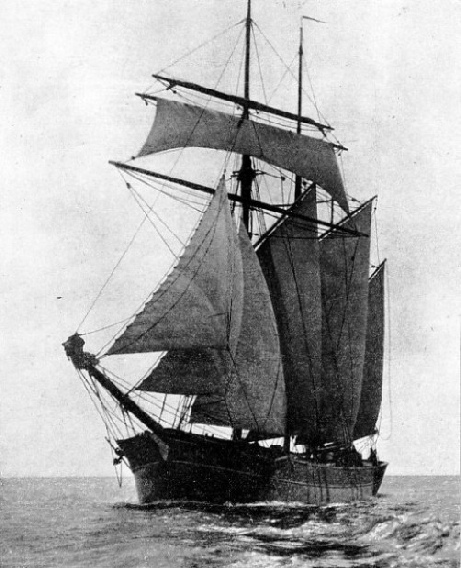 number of changes have been introduced during the development of the sailing vessel, and in addition local needs have demanded innumerable local variations.
number of changes have been introduced during the development of the sailing vessel, and in addition local needs have demanded innumerable local variations.
TOPSAIL SCHOONERS have square topsails on the foremast and occasionally on the mainmast as well. The Englishman is a three-masted topsail schooner of 144 tons gross. She was built in 1864 and sank while at anchor off the Pembrokeshire coast on May 5, 1933. The Englishman was 94 feet long, with a beam of 22 ft. 8 in.
Click here to see further types of ships’ rig.
You can read more on “Romance of the Racing Clippers”, “Standing and Running Rigging” and “Training in Sail To-day” on this website.











 number of changes have been introduced during the development of the sailing vessel, and in addition local needs have demanded innumerable local variations.
number of changes have been introduced during the development of the sailing vessel, and in addition local needs have demanded innumerable local variations.